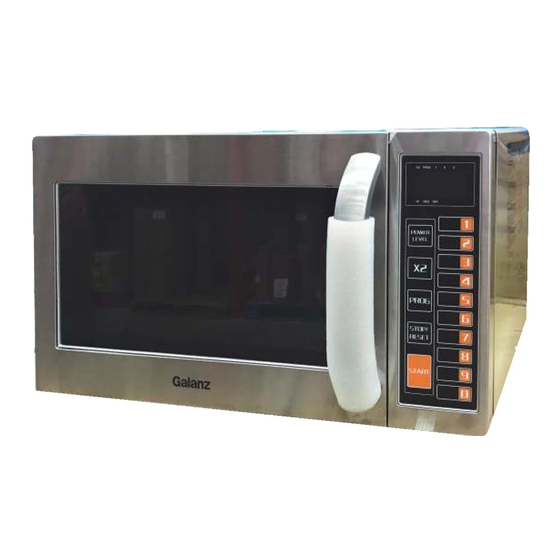- ページ 12
電子レンジ Galanz P100M25ASL-5SのPDF ユーザーマニュアルをオンラインで閲覧またはダウンロードできます。Galanz P100M25ASL-5S 13 ページ。

traced to overheating.
M
ICROWAVE BASICS
A number of factors determine the success of microwave food preparation. They include:
1.
Temperature of foods: frozen or refrigerated food items require longer heating times to reach a
desired serving temperature than foods from room temperature.
2.
Food components: foods high in sugar, salt, fats and moisture content heat faster because these
properties attract microwave energy. Denser foods high in protein and fiber, absorb microwave
energy slower which means a lengthier heating time.
3.
Bulk/volume: the greater the mass of food, the longer it takes to heat.
4.
Containers: ceramic, paper, china, Styrofoam, glass and plastic are suitable for use in microwave
ovens with the following caution. Heating foods with either high sugar or high fat content should
be done only in high temperature resistant containers since these foods get very hot. Using
Styrofoam containers for these foods with cause the Styrofoam to warp. Other low temperature
restaurant glass or plastic platters may crack or warp under similar conditions. Do not heat food in
a sealed container or bag. Foods expand when heated and can break the container or bag.
5.
Avoid metal: because it bounces the microwaves, causing uneven heating and sometimes even
flashes, which may pit or mar the interior of the oven, the metal container or plate trim.
6.
Heated liquids can erupt if not mixed with air. Do not heat liquids in your microwave oven without
first stirring.
Turn off the oven and remove the power
1.
plug from the wall socket before cleaning.
Keep the inside of the oven clean. When
2.
food splatters or spilled liquids adhere to
oven walls, wipe with a damp cloth. Mild
detergent may be used if the oven gets
very dirty. Avoid the use of spray and other
harsh cleaners as they may stain, streak
or dull the door surface.
3.
The outside surfaces should be cleaned
with a damp cloth. To prevent damage to
the operating parts inside the oven, water
should not be allowed to seep into the
ventilation openings.
4.
Wipe the window on both sides with a
damp cloth to remove any spills or
C
L
E
A
N
I
N
G
A
C
L
E
A
N
I
N
G
A
11
N
D
C
A
R
E
N
D
C
A
R
E
spatters.
Do not allow the control panel to become
5.
wet. Clean with a soft, damp cloth. When
cleaning the control panel, leave oven
door
open
to
accidentally turning on.
If steam accumulates inside or around the
6.
outside of the oven door, wipe with a soft
cloth. This may occur when the microwave
oven is operated under high humidity
conditions. In such case, it is normal.
The roller ring and oven floor should be
7.
cleaned regularly to avoid excessive noise.
Simply wipe the bottom surface of the
oven with mild detergent. The roller ring
may be washed in mild sudsy water or
prevent
oven
from
